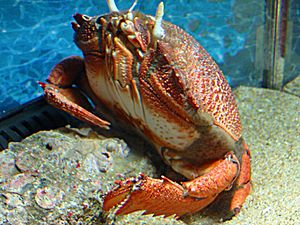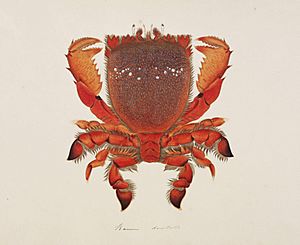Spanner crab facts for kids
Quick facts for kids Ranina ranina |
|
|---|---|
 |
|
| Scientific classification | |
| Kingdom: | |
| Phylum: | |
| Subphylum: | |
| Class: | |
| Order: | |
| Infraorder: | |
| Family: |
Raninidae
|
| Genus: |
Ranina
Lamarck, 1801
|
| Species: |
R. ranina
|
| Binomial name | |
| Ranina ranina (Linnaeus, 1758)
|
|
| Synonyms | |
|
|
The frog crab, also called the spanner crab, is a special kind of crab. You can find it in warm, tropical and subtropical parts of the world. People often catch these crabs because their meat is tasty. It's the only known species in its group, which makes it quite unique!
Contents
What Does the Frog Crab Look Like?
This crab can grow up to about 150 millimetres (5.9 in) (6 inches) long. It can weigh as much as 900 grams (2.0 lb) (2 pounds). Its top shell, called a carapace, is wider at the front. It has a reddish-brown color with ten white spots.
Frog crabs are mostly active at night. During the day, they stay hidden. They bury themselves in the sand to rest. You can easily tell a frog crab apart from other crabs. Just look for its red shell and its long middle section.
Where Do Frog Crabs Live?
Spanner crabs live in coastal waters. You can find them along the east coast of Australia. This includes areas from Yeppoon in Queensland to northern New South Wales. There's also a group of them north of Perth in Western Australia.
These crabs are also common in the Philippines. They live in the coastal waters of south-western Mindanao. You can also find them from the eastern coast of Africa, across the Indian Ocean, to places like Indonesia, Japan, Hawaii, and Vietnam.
Frog Crab Habitat
Ranina ranina lives in waters that are 10–100 metres (33–328 ft) (33–328 feet) deep. They prefer sandy, smooth areas on the ocean floor. They bury themselves in the sand to wait for small fish to swim by. This is how they catch their food.
When a frog crab is waiting for prey, it covers itself with sand. It leaves its eyes and mouth sticking out. This helps it spot food. For frog crabs to do well, their habitat must have plenty of sand. Burying themselves is key to how they hunt.
Why Are Frog Crabs Fished?
People fish for Ranina ranina in many places where it lives. The biggest fishery is in Australia. About 3,592 tonnes (7,919,000 lb) (7.9 million pounds) are caught there each year. In Queensland, only adult crabs larger than 100 mm (3.9 in) (4 inches) can be caught.
In the Philippines in 2008, frog crabs sold for about 200–300 pesos per kilogram. That's about $4–$6 USD per kilogram. Scientists keep an eye on frog crab numbers. This helps make sure too many are not caught. Right now, their populations are stable.
Scientists are still learning about these crabs. We don't know much about their life or how their groups grow. People have tried to raise frog crabs in special tanks. But so far, it has been hard to do successfully.
How Are Frog Crabs Eaten?
The frog crab is a special food in some parts of the Philippines. There, it's called curacha. People usually eat it steamed, which is called halabos. Or, they cook it in coconut milk, known as ginataan. A famous version of the coconut milk dish is curacha Alavar from Zamboanga City.


